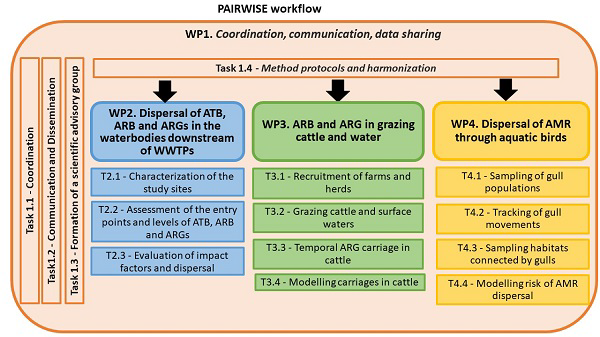PAIRWISE
Dispersal of antIbiotic resistance and antibiotics in water ecosystems and influence on livestock and aquatic wildlife.
Partners
Partners
Norwegian Institute for Water Research (NIVA)
Linköping University (LiU)
Estación Biológica de Doñana, Consejo Superior de Investigaciones Cientificas (EBD-CSIC)
National Research Institute for Rural Engineering, Water, and Forestry (INRGREF)
Faculty of medicine Ibn Al-Jazzar Sousse (FMS)
Makerere University (MAK)
Abstract
Abstract
PAIRWISE aims to advance knowledge of antimicrobial resistance as a pollution in aquatic environments, wildlife, and livestock. PAIRWISE focuses on dispersal and dynamics of antibiotic resistant bacteria, antibiotic resistance genes and antibiotics in aquatic environments affected by wastewater treatment plants (WWTPs).
Overall goals are to understand:
- i) dispersal of antibiotic resistant bacteria, antibiotic resistance genes and antibiotics
in surface waters downstream of WWTPs, - ii) the carriage of antibiotic resistant bacteria and antibiotic resistance genes in
livestock linked to surface waters influenced by WWTPs, - iii) role of aquatic birds in the dispersal of antibiotic resistant bacteria and antibiotic
resistance genes.
Issues from the JPI call tackled by PAIRWISE include, but are not limited to entry points and fate of antibiotic resistant bacteria (ARB), antibiotic resistance genes (ARGs) and antibiotics (ATB); identification of ARGs and ARB useful as indicators; providing insight to fate and transport of ARB, ARGs and ATB to, within, and from aquatic ecosystems, and
the role of aquatic birds in such events.
PAIRWISE will assess the influence of antimicrobial resistance in agricultural settings and improve understanding of the dissemination and sustainment of antimicrobial resistance in the interface between humans, wildlife, and livestock with a One Health perspective. It will provide vital knowledge for policymakers and end-users, facilitating informed decisions on mitigation strategies.
WP structure
WP structure
WP number | Led by |
| WP1 | SVA |
| WP2 | NIVA |
| WP3 | MAK |
| WP4 | LiU |

Expected research results
Expected research results
- A tangible estimation of the level of contamination of aquatic environment and distribution of antibiotics, antibiotic resistant bacteria and antibiotic resistance genes.
- Knowledge on the transmission of antibiotic resistant bacteria and antibiotic resistance genes between wild birds and livestock on grasslands, and the role of water.
- Knowledge of spatial and temporal dissemination and dispersal of antibiotic resistant bacteria and antibiotic resistance genes with birds, locally and long-distance.
- Knowledge of the role of wastewater treatment plants from human settlements in the dispersal of antibiotic resistant bacteria and antibiotic resistance genes to the environment – surface water, wild birds and livestock.